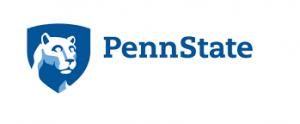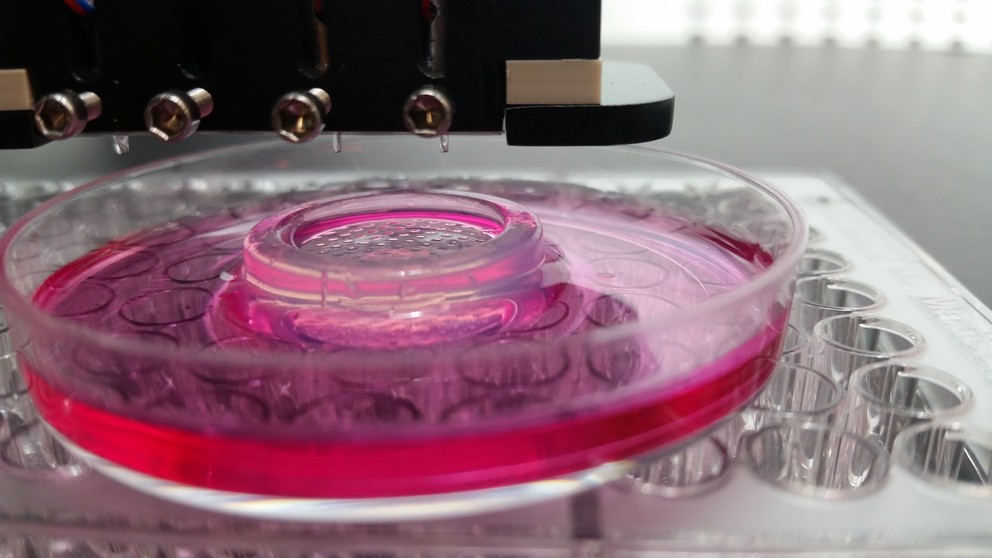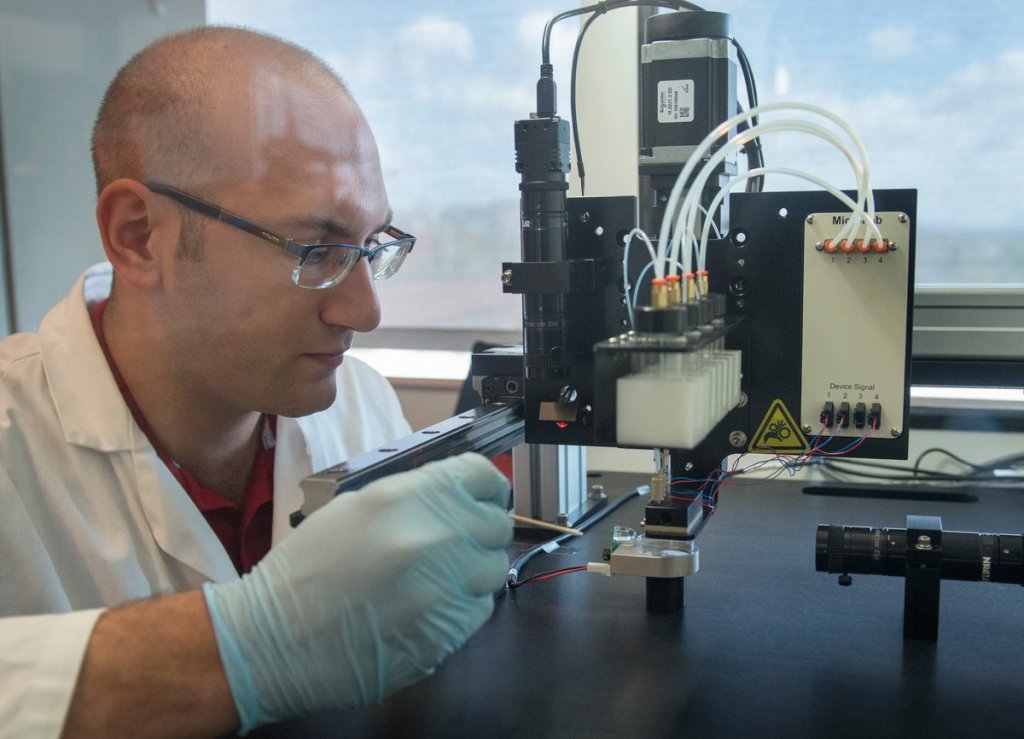 At universities across the United States, funding is helping academic research of scientific processes advance the medical field, especially when it comes to bioengineered tissues and organoids that could help solve some of the major problems for the future of medicine. A lot of research is needed to create a fundamental base that leads to more applied developments. Just last week, Ibrahim Tarik Ozbolat, Hartz Family Career Development Associate Professor of Engineering Science and Mechanics at Pennsylvania State University (Penn State), received grants totaling 1.5 million dollars for research into bioprinting. At University Park, in Pennsylvania, Ozbolat will explore ways to bioprint biological tissues like bone, lungs and other organs for use as models in four different medicine-related studies.
At universities across the United States, funding is helping academic research of scientific processes advance the medical field, especially when it comes to bioengineered tissues and organoids that could help solve some of the major problems for the future of medicine. A lot of research is needed to create a fundamental base that leads to more applied developments. Just last week, Ibrahim Tarik Ozbolat, Hartz Family Career Development Associate Professor of Engineering Science and Mechanics at Pennsylvania State University (Penn State), received grants totaling 1.5 million dollars for research into bioprinting. At University Park, in Pennsylvania, Ozbolat will explore ways to bioprint biological tissues like bone, lungs and other organs for use as models in four different medicine-related studies.
To explore a new process for 3D bioprinting that could be a solid base for the future creation of implantable, bioengineered tissues and organs, the National Science Foundation (NSF) has awarded him a three-year, $448,539 grant. These bioprinted organs and tissue would not require immunosuppressant drugs or have other shortcomings associated with transplants.
Ozbolat will use an aspiration-assisted bioprinting process to position the building blocks of tissue rapidly and precisely so that tissues and tissue models to use for drug development, lesion studies or replacement parts become possible. The project will investigate a number of current questions about bioprinting of cell spheroids, their size, density, mechanics, placement and ability to survive. 3DPrint.com spoke with Ozbolat about the projects he is undertaking to try to understand some of the possibilities and limitations in the field. At the lab, the expert engineer is making different kinds of tissues, including cartilage, pancreas, tumor models, heart and skin tissues.
“The long term goal of this project is to develop a bioprinting process that will enable precise bioprinting of spheroids, for example for an organ-on-chip device to create a pancreas model. So we are trying to determine how bioprinting contributes to the device development, pancreas tissue printing or organ printing that could eventually cure Type 1 diabetes. But there are quite a few limitations since it is an autoimmune disease, specifically, that whenever a pancreas device or tissue-based implant from patients own cells is developed, you also need to protect that device and the cells from an immune attack, needing the highest amount of vascularization in it so that you have the highest viability. It is a problem with any device fabrication that goes into the body and people working in the field are still trying to find a way to work around that hurdle,” said Ozbolat.
At the lab, Ozbolat and his team work with commercial bioprinters from brands like Cellink, MicroFab, and Turkish Axolotl Biosystems. They also have custom-made machines from various companies, and the lab engineers modify some of the existing printers to suit their needs. Since the new aspiration-assisted bioprinting process only uses XYZ motion system, they modified an already existing MakerBot extrusion system bioprinter at the lab.
Ozbolat is also a subcontractor for a new National Institutes of Health (NIH) Cooperative Center on Human Immunology (CCHI) supported by a five-year, $11 million grant to the Jackson Laboratory (JAX) by the National Institute of Allergy and Infectious Diseases (NIAID). His $900,000 will support the development of 3D bioprinted models of the lung and upper respiratory environment to mimic and explore the functional lung and immune system interactions and determine the mechanisms and pathways involved in lung antiviral response or response to metabolic agents. Thanks to the grant, a major new research center led by JAX Professor Karolina Palucka will explore the mechanisms of antiviral lung immune function and the role of our lung microbiome. The CCHI will also investigate lung immune responses to viral infection, bringing together scientists who specialize in different fields, like Ozbolat from bioengineering.
“My goal is to bioprint a lung tissue model platform that scientists can use to understand the interactions of the immune cells when they reach the virus. This means that they can test out the different hypothesis during the inflammation and infection process. We are not really interested in making an entire lung, the goal is to create an alveolar structure with blood vessels for the immune cells and bacteria growing in the alveolar section to learn how they interact,” explained Ozbolat, who will use an extrusion bioprinting process to create the lung model in the case.
The third project that is receiving a grant is focusing on bioprinting bone. Ozbolat, along with Elias Rizk, associate professor of neurosurgery at Penn State College of Medicine, will explore using 3D bioprinting capabilities to repair critical-sized bone defects on three-year-old Rhoen sheep to investigate the feasibility of repairing skull, jaw and facial injuries or defects. The two-year work will be awarded $75,000 from the Osteology Foundation in Switzerland. The goal is to develop ways to transfer this bioprinting method to clinical use and to build the fundamentals of tissue printing technologies for surgical settings.
“To fix the cranial bone deffects on the skull, we will tackle bioprinting bone tissue on sheep, something we have already tested on rats. Our ultimate goal is to translate the bioprinters technology so that they can be used as surgical robots to repair cranial deffects in surgery and have full control of the robotic arm. Before ever getting to the human trial stage, we need to test the procedure in large animals, and will be working with a specialist who will perform the surgeries, along with a veterinarian team.”
Also focusing on bone is a $65,000 grant to create a 3D bone tissue model to study Gaucher disease from the Lysosomal and Rare Disorders Research and Treatment Center. Gaucher disease is an inherited genetic disorder that among other things can create bone abnormalities and arthritis that may be the result of alterations in cellular and/or humoral immunity. The focus of the research project is to bioprint a model in which to study Gaucher disease in the laboratory and to understand the 3D interactions in a bone model using cells from patients in the treatment center.
Ozbolat’s background and experience at the Penn State lab make it easier to find setbacks in the medical field which he can attempt to solve with bioprinting; other times, professional medical practitioners ask him and his team for help solving some of the hurdles they encounter. He has been doing research for many years at the Penn State engineering lab, tackling medical problems that affect thousands of patients. Some three years ago, he even began developing a new method of bioprinting that could eventually be used to create cartilage patches for worn-out joints: a potential cure for osteoarthritis, a problem that affects people all over the world and is very painful.
“These are problems we want to solve and find solutions for, although many of them are still not ready for clinical trials, so they need 3D tissue models to investigate responses.”
Ozbolat has many different projects in various tissue types, like cancer immune therapy, working alongside Jackson Lab immunologist Derya Unutmaz, who engineers immune cells for Ozbolat to use them in a 3D printed tumor platform to test several hypotheses and work on different scenarios. Last year, the experienced engineer, along with fellow researchers at Penn State, created tissues with micropores that allow nutrient and oxygen diffusion into the core of the cell as an alternative to vascularization, or growing blood vessels inside the tissue. Historically, funding in academic research has helped advance humankind, grants like the ones Ozbolat is receiving are crucial for biomedical developments and devices, making it possible to answer fundamental questions and develop new therapies for many disorders.
[Images: Ozbolat LAB / Penn State University]Subscribe to Our Email Newsletter
Stay up-to-date on all the latest news from the 3D printing industry and receive information and offers from third party vendors.
Print Services
Upload your 3D Models and get them printed quickly and efficiently.
You May Also Like
3D Printing News Briefs, July 2, 2025: Copper Alloys, Defense Manufacturing, & More
We’re starting off with metals in today’s 3D Printing News Briefs, as Farsoon has unveiled a large-scale AM solution for copper alloys, and Meltio used its wire-laser metal solution to...
3DPOD 260: John Hart on VulcanForms, MIT, Desktop Metal and More
John Hart is a Professor at MIT; he´s also the director of the Laboratory for Manufacturing and Productivity as well as the director of the Center for Advanced Production Technologies....
3D Printing News Briefs, June 28, 2025: Defense Accelerator, Surgical Models, & More
In this weekend’s 3D Printing News Briefs, 3YOURMIND was selected to join an EU Defense Accelerator, and PTC has announced model-based definition (MBD) capabilities within Onshape. Finally, a study out...
EOS in India: AM’s Rising Star
EOS is doubling down on India. With a growing base of aerospace startups, new government policies, and a massive engineering workforce, India is quickly becoming one of the most important...



































